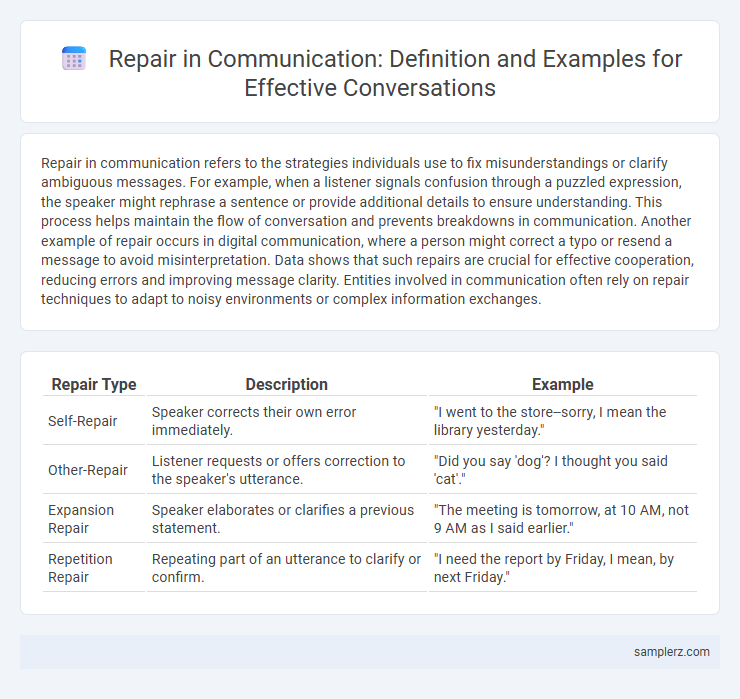Repair in communication refers to the strategies individuals use to fix misunderstandings or clarify ambiguous messages. For example, when a listener signals confusion through a puzzled expression, the speaker might rephrase a sentence or provide additional details to ensure understanding. This process helps maintain the flow of conversation and prevents breakdowns in communication. Another example of repair occurs in digital communication, where a person might correct a typo or resend a message to avoid misinterpretation. Data shows that such repairs are crucial for effective cooperation, reducing errors and improving message clarity. Entities involved in communication often rely on repair techniques to adapt to noisy environments or complex information exchanges.
Table of Comparison
| Repair Type | Description | Example |
|---|---|---|
| Self-Repair | Speaker corrects their own error immediately. | "I went to the store--sorry, I mean the library yesterday." |
| Other-Repair | Listener requests or offers correction to the speaker's utterance. | "Did you say 'dog'? I thought you said 'cat'." |
| Expansion Repair | Speaker elaborates or clarifies a previous statement. | "The meeting is tomorrow, at 10 AM, not 9 AM as I said earlier." |
| Repetition Repair | Repeating part of an utterance to clarify or confirm. | "I need the report by Friday, I mean, by next Friday." |
Understanding Repair in Communication
Understanding repair in communication involves identifying and resolving misunderstandings or breakdowns in conversation. For example, a speaker may repeat or rephrase a sentence after noticing a listener's confused expression, aiming to clarify meaning and ensure accurate comprehension. Such repair mechanisms enhance mutual understanding and maintain effective dialogue flow.
Types of Repair Strategies
Repair strategies in communication include self-initiated repair, where the speaker detects and corrects their own errors, and other-initiated repair, which involves the listener signaling a problem that prompts correction. Examples of repair types encompass rephrasing, repetition, and clarification requests that aim to restore mutual understanding. Conversational implicature and turn-taking adjustments also function as subtle repair mechanisms to maintain effective interaction flow.
Common Scenarios Requiring Repair
Common scenarios requiring repair in communication include misunderstandings caused by ambiguous language, interruptions during conversations, and technical issues in digital communication platforms. Misinterpretations often occur when speakers use vague terms or jargon unfamiliar to the listener, necessitating clarification. Interruptions disrupt the flow of dialogue, prompting participants to restate or elaborate their points to maintain mutual understanding.
Examples of Self-Initiated Repair
Self-initiated repair in communication occurs when a speaker recognizes and corrects their own error to clarify meaning, such as repeating a misunderstood word or rephrasing a confusing sentence. For example, a person might say, "I mean, the meeting is at 3 p.m., not 2 p.m.," immediately correcting the initial mistake. This type of repair enhances conversational efficiency and helps prevent misunderstandings by ensuring accurate message delivery.
Examples of Other-Initiated Repair
Other-initiated repair occurs when a listener detects a problem in understanding and prompts the speaker to clarify, such as asking "What do you mean by that?" or saying "Could you repeat the last part?". Examples include requests for repetition, clarification questions, and confirmation checks that ensure mutual understanding in conversation. This repair mechanism is crucial in maintaining effective communication and preventing misunderstandings.
Repair Techniques in Verbal Communication
Repair techniques in verbal communication include clarification requests, repetition, and paraphrasing to resolve misunderstandings. Speakers often ask for repetition or rephrase statements to ensure mutual comprehension. These strategies enhance conversational flow and reduce breakdowns in dialogue.
Repair in Nonverbal Interactions
Repair in nonverbal interactions often involves gestures such as a clarifying nod or facial expression adjustment to resolve misunderstandings during conversations. Eye contact can be reestablished intentionally to signal attentiveness and correct previous disengagement. These subtle nonverbal cues play a critical role in maintaining mutual understanding when verbal communication fails.
Repair in Cross-Cultural Communication
Repair in cross-cultural communication often involves clarifying ambiguous language or addressing misunderstandings caused by differing cultural norms and speech conventions. Strategies such as requesting repetition, rephrasing statements, or explicitly explaining idiomatic expressions help prevent misinterpretations and maintain effective dialogue. These repair mechanisms are essential for fostering mutual understanding in diverse communication settings.
The Role of Clarification Requests
Clarification requests play a crucial role in communication repair by helping speakers identify and resolve misunderstandings promptly. For example, when a listener says, "Do you mean the meeting is at 3 p.m. or 4 p.m.?" it prompts the speaker to clarify the exact time, preventing confusion. This interaction enhances mutual understanding and ensures the message is accurately conveyed.
Effective Phrases for Communication Repair
Effective phrases for communication repair include clarifying questions such as "Could you please explain what you meant by that?" and polite requests like "I'm not sure I understood correctly, can you rephrase that?" Using statements like "Let me confirm if I got this right" helps in preventing misunderstandings and ensures the message is accurately conveyed.

example of repair in communication Infographic
 samplerz.com
samplerz.com